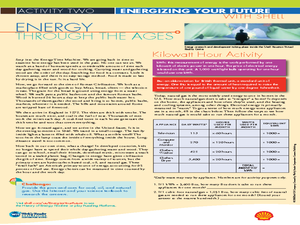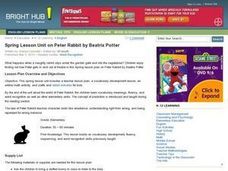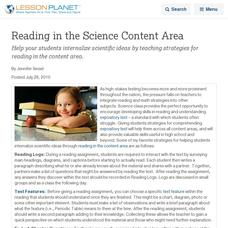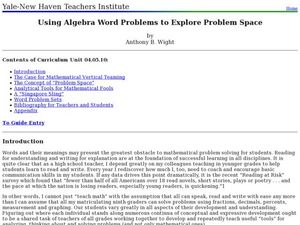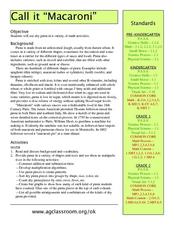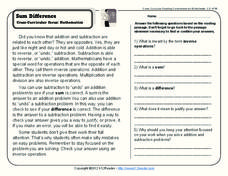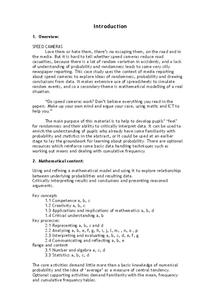Curated OER
Using Factor Trees
In this math activity, students read about how to create a factor tree. Students use factor trees to determine the prime factors of 16 numbers.
Curated OER
School Fair Cakewalk
Students identify and research various suitable school carnival activities. Then they work together to plan, design, and run all aspects of a school carnival. Students also add up their costs for the event and the amount of money it...
Curated OER
How To Build a Planet From The Inside Out!
High schoolers read about the Spitzer Space Telescope and the technology used to learn about planet composition. They calculate the radius of a planet, the size of a planet, the average density of a planet and the likely core composition...
Curated OER
Energy Through the Ages
In this energy through the ages learning exercise, students read about the history of energy use beginning with early civilization and the use of water wheels for the production of energy to hydrocarbon-based coal, oil and natural gas of...
Recorded Books
Teacher's Guide: The Pinballs
Dive your class into the novel The Pinballs by Betsy Byars with the support of this reading guide. Including short answer questions, a multiple choice comprehension quiz, and extension activities, a variety of materials are...
Curated OER
Graphing Stories Ice Breaker
Kick off the school year with some math fun! New classmates share information about themselves by using graphs and interpreting data. The goal is to use a general graph shape, such as linear or exponential, and create labels for the axes...
Scholastic
Prescription Pain Medication: What You Need to Know
The national epidemic of opioid addiction is making its way into high school populations. Educate the young scholars in your class about the ways prescription opioids can both block pain and deliver large amounts of dopamine that make it...
Curated OER
Spring Lesson Unit on Peter Rabbit by Beatrix Potter
Students read about Peter Rabbit. In this lesson plan, about reading and comprehension, students listen to the story, The Tale of Peter Rabbit, by Beatrix Potter. Students answer questions about the story to determine comprehension....
Curated OER
Reading in the Science Content Area
Help your students internalize scientific ideas by teaching strategies for reading in the content area.
Curated OER
Introduce Vocabulary: Sorting (Pluckrose)
Find guidance to introduce math vocabulary in context using Henry Pluckrose's book Sorting. This text is an excellent cross-curricular resource for budding readers. Before starting, review some new vocabulary words: collect, common,...
K12 Reader
Geometric Shape Names
Combine math and language arts in the same lesson with a reading passage about number prefixes in geometric shapes. After reading several short paragraphs about the different prefixes used in shape names, kids answer five comprehension...
K12 Reader
Galileo and His Telescope
Learn about Galileo Galilei's contribution to modern science with a reading passage that focuses on reading comprehension. After kids read several paragraphs about his life, they answer five questions about the information they have just...
Curated OER
Grading Khan Academy
Who is Salman Khan? That is the first question learners will answer after reading a New York Times article about the online math and science educator. They'll read the article and respond to eight questions that ask, who, what, when,...
Curated OER
Using Algebra to Explore Problem Space
Students apply their knowledge of math by rewriting word problems using equations. In this word problem lesson, students build upon previous knowledge as they set up the correct steps to solve word problems. This lesson is full of hints...
Curated OER
Call it "Macaroni"
Who knew there were so many fun educational opportunities featuring pasta? Scholars read a brief informational text about the history of pasta (note that "macaroni" is spelled two different ways, so address this if kids are reading...
Curated OER
Number Puzzles
These math puzzles are sure to get your first and second graders thinking. Nine word problems about odds and evens, as well as greater than and less than, keep learners guessing. If you're working on mental math in your class, use these...
K12 Reader
Sum Difference
If you need a way to address math and reading in one lesson, look no further than a passage about inverse operations, complete with reading comprehension questions. Kids focus on context clues to determine the meanings of unfamiliar words.
K12 Reader
Elements & Atoms
Study matter in a new way with a cross-curricular assignment for language arts and math. Learners answer five reading comprehension questions after reading a few paragraphs about the periodic table, properties of elements, and how atoms...
K12 Reader
Kinds of Angles
Have you ever wondered how circles and angles relate to each other? Read a passage about right angles, acute angles, and obtuse angles, and answer reading comprehension questions about the information you learn.
K12 Reader
3-D: It’s Not Just for Movies
This two-part reading comprehension exercise asks kids to read a short passage about cubes, rectangular prisms, spheres and pyramids, and then to respond to a series of questions about the article.
Curated OER
Real-Life Problems: Measures
Do your fifth graders have trouble writing out their work for word problems? Use this instructional activity about measurements and the four equations, which provides separate spaces to write the equations and the answers. A nice way to...
Curated OER
Reacting to the Rapture
FamilyRadio.com publicized that the Rapture or Judgement Day would happen on May 21, 2011, it didn't. Informed students read a New York Times article on the topic, then answer nine related comprehension questions.
Bowland
Speed Cameras
Do speed cameras help reduce accidents? Scholars investigate this question using a series of spreadsheet activities. Along the way, they learn about randomness, probability, and statistical analysis.
Curated OER
Operation Spaghetti
Find the math in recipes. Young chefs will follow a recipe and investigate the total cost for materials. They measure amounts of food necessary for the recipe and compute the per person cost.



